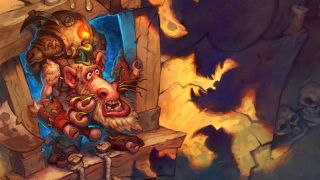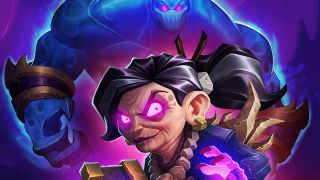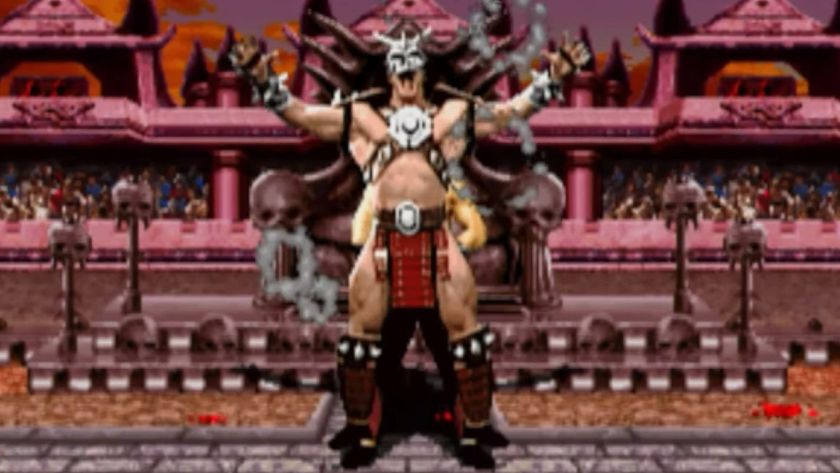Delving into the design decisions behind Dungeon Runs and Devourers in Hearthstone's Kobolds & Catacombs
It's only been a week since the debut of Hearthstone's newest set, Kobolds & Catacombs - but, as with any great expansion, it already feels like so much has changed. The new Dungeon Run mode, which is completely free and has proved ridiculously replayable, is a breath of fresh air for single-player content in card games. Over in the tournament scene the pros are still trying to optimize decks to make room for all the exciting new cards and powerful Legendaries. Now that we've seen everything in the set and embarked on dozens of Dungeon Runs, we asked the Hearthstone team what it takes to design these enticing modes and cards, along with just how far they're willing to go for a reprehensible pun.
"We started working on Kobolds & Catacombs with a strong sense for the fantasy," explains game designer Dave Kosak. "We knew what we wanted to get out of the set, and I think the whole team was really excited about that. We’ve all had experiences, from childhood onward, of exploring dungeons with our friends, whether in a computer or tabletop game, and we really wanted to capture that. And I think we did. Everything from the candle-lit board, to the loot and Dungeon Run treasures - everything feels like it drove home that fantasy of running through a dungeon, picking up loot, fighting monsters, and never knowing what’s around the next corner."

Anyone who's fought their way through raids in World of Warcraft or harrowing campaigns in Dungeons & Dragons can attest to how Dungeon Run perfectly captures that same sense of escalating danger and excitement. As you continue to beat bosses and fine-tune your deck with additional cards chosen for their sweet synergies, the encounters ramp up from easy to brutally difficult, and losing once means starting all over again. "Our goal was to create something that was fun and replayable," says game designer Peter Whalen. "But we also got some other good things out of it, like the educational benefits of the mode."
Whalen's referring to how Dungeon Runs give you the chance to play around with different builds and powerful Legendary cards without needing to actually own them first, as well as observe interesting interactions between cards from all throughout Hearthstone history. "It’s a super valuable learning tool, because it teaches you the deckbuilding process over time by letting you experiment with lots of different cards that do different things and have distinct win-conditions," adds Kosak. "It can be a bit intimidating, because you often have to choose between cards you may have never seen before, but that’s part of the fun - if your deck doesn’t work out, you can jump right back in." It's also a great introduction to some of the fresh mechanics in K&C, like the Recruit ability that can summon one or more minions from your deck straight onto the battlefield.

As for the new cards themselves, K&C offered some incredibly strong additions, like the Corridor Creeper that can essentially become a free 5/5, the card-drawing machine that is Aluneth, or Rogue's new Kingsbane weapon that created a new deck archetype all by itself. But Kosak and Whalen agree on which card they were most eager to see players' response to: Rin, the First Disciple. This Warlock Legendary is a decent taunt minion on her own, but when she dies, you start a series of spells that ends in total destruction if you can pull it off in time. "It’s a lengthy sequence that you have to go through, and during it, you wonder, 'What could possibly be worth this?'" laughs Kosak.
Thankfully, the payoff is supreme: eventually you can summon the 10/10 minion Azari, the Devourer who instantly eats your opponent's entire deck when cast. It's such a game-changing effect that Rin - who might've initially seemed like a 'just for fun' card - has already found her way into competitive decks that use taunt minions to stall out early aggression and eventually devour the enemy deck in one big gulp. "When epic things like that happen, we want powerful effects to make players feel like they just did something devastating," says Kosak.
That's accomplished through subtle-but-significant visual flourishes, which you can see being crafted in the behind-the-scenes video below. "Our effects team is top-notch, and they work really hard to make our cards and effects feel as cool as possible," says Kosak. "Voiceover and sound effects are also super important, and when those come together with the graphics, they really bring the board to life. All these elements working in tandem go a long way toward giving Hearthstone its spirit."
Sign up to the 12DOVE Newsletter
Weekly digests, tales from the communities you love, and more
Even the tiniest minion is designed with the utmost care. "The stories behind each card are brought to life by a bunch of small details," says Whalen. "The card’s name, its mechanics, the 2D art, the effects when it comes into play, the sounds associated with it - whether they’re spoken or not - and the music that’s played when the card hits the field... all those pieces tell the story of what’s special about each card. Sometimes, the flavor text is a part of the story, too. Writing collectible card voiceover is tricky, and takes a lot of iteration and practice. When I work with the designers on this, one of the things we try to do is make each card unique; to create dialogue that is singularly appropriate to it. One of my favorites is, 'Today, I don’t have to be a princess.' That one line tells a complete story, and it only makes sense for one card: Brave Archer. That’s the key to Hearthstone VO."
"You certainly don’t have much room when it comes to card text," adds Kosak. "It’s all about what the card says, what it looks like, and how it sounds - all of that has to work together to tell a story. When it does, you get a neat little card, like Annoy-A-Tron, that becomes a fan favorite because it’s a whole package." That room for silly-yet-viable cards like Annoy-A-Tron is part of Hearthstone's enduring charm - and gives the Hearthstone design team the opportunity to revel in some pun-tastic wordplay, like new K&C minion Zola the Gorgon. They'll deny everything, of course. "Hearthstone never has any puns," Kosak says with a smile. "Hearthstone is an extremely serious franchise. I think it’s probably Blizzard’s most dark, gritty, and realistic franchise."
Whalen has to concede. "To be fair, Zola the Gorgon was cheesy... even for us."
Lucas Sullivan is the former US Managing Editor of 12DOVE. Lucas spent seven years working for GR, starting as an Associate Editor in 2012 before climbing the ranks. He left us in 2019 to pursue a career path on the other side of the fence, joining 2K Games as a Global Content Manager. Lucas doesn't get to write about games like Borderlands and Mafia anymore, but he does get to help make and market them.
Most Popular






